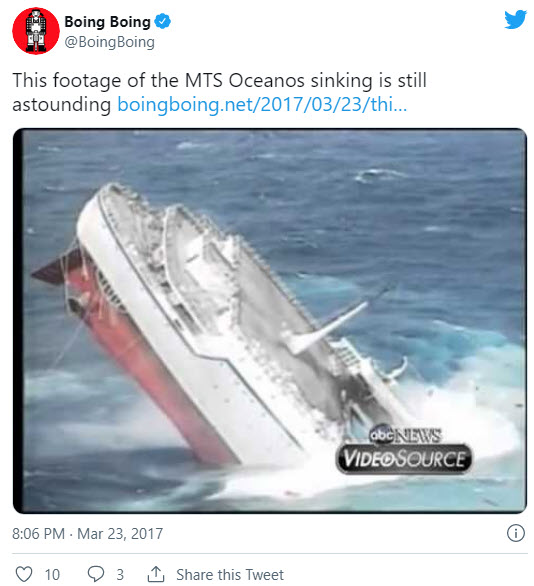| Even though all the passengers of the Oceanos were saved, what reputational damage may have occurred due to the incident? What “hard” reputational risk indicators did the owners of the Oceanos need to consider in order to track their reputational risk during and after the incident?
Further research shows that Oceanos did suffer reputational damage. Blunden and Thirlwell (2013) suggested that reputational damage can be measured through various economic variables like a drop in sales, loss of earnings, the cost of managing the crisis, change of the share price and market capitalization. The two went on and said that it is difficult to make direct correlations between these economic measures and the assumed loss of reputation the organisation might face or the long-term impact on trust. The easy way to meas ure the impact on reputational risk is through the use of goodwill. Given the case of putting the lives of people on the line, Oceanos did suffer lost its goodwill, thus one would conclude that Oceanos did suffer reputational damage. Based on the notion that it is difficult to link the variables to reputational damage, it is also difficult to link damage suffered by Oceanos on certain variables. The case did not mention if the company was listed or not , there is no mention of whether the company discontinued its operations. Blunden and Thirlwell (2013) presented a scale of measuring the reputation damage, from 1 to 6, with level six have serious damage. With the list under level 6, one would suggest that Oceanos did actually suffered reputation damage. Among those include sustained negative national and international media coverage, large-scale customer loss. Sustained media outlast even today, with visible images and videos on the internet and social media, do actually dedicate that Oceanos did actually suffered this form of reputational damage. Tracking reputational risk Blunden and Thirlwell (2013) argued that social media plays a greater role in tracking reputational risk. In addition to this, the two went on and said that the monitoring of perceptions of the organisation’s reputation is very important towards reputation risk management. Tracking and monitoring of the perception or changing in the perceptions of stakeholders can be done through the use of surveys.
According to Blunden and Thirlwell (2013) “identifying reputation risk and new reputation risk stakeholders should also be considered as a standard item during discussions on strategy, or about new projects or products.” With this in mind, a risk register with various stakeholders can as well be used to track reputational risk, as the expectation and reactions of each and every stakeholder will be tracked on the risk register. The hard indicators that are used to track reputation risk include Ø decline in revenues Ø decline in market share Ø difference between the market value and liquidation value of the firm (effectively the movement in the value of goodwill in the firm) Ø number of customer complaints Ø number of product recalls Ø increase in regulatory attention Ø firm’s position on a publicly recognised reputation index. Ø loss of a licence Ø adverse media campaign Ø legal dispute Ø loss of employees’ trust (e.g., following a whistle-blower event) Ø adverse perception of selected products and services by customers Ø investigation by the regulator and resultant publicity. Reputational risk after the incident Ø Difficulty in raising capital – due to reputational damage an organisation like Oceanos, might lose investors’ confidence in the stock market and thus making it difficult for the company to gain or raise capital in the form of equity. Therefore, in tracking reputational risk, the owners and management may look for this sign in the form of struggling to raise finance. It can also face difficulties in raising debt finance as debt providers will not be willing to work with this organisation, therefore the backlash from debt providers can be another indicator that can be tracked during and after the incident by the owners and management. Ø social media – Bad memories about Oceanos are still available and do appear on social media, despite the fact that the event happened in 1991. Therefore, in tracking reputation risk, social media does play a great role, and organisations should identify individuals who will be responsible for managing the publicity of the organisation on social media. Ø Loss of key employees – very few employees are willing to continue working for a company after a major blow to the reputation of the organisation, due to the uncertainty surrounding the future of the organisation. As a result, high labour turnover can be an indicator to track the severity of the reputational damage of the organisation. This is applicable after the event, as more employees will decide to leave the organisation. Ø Loss of suppliers – loss of suppliers who will decide not to work with Oceanos can also be used to track the severity of reputational damage. With the loss of key and strategic suppliers showing greater reputational damage. Based on the recommendations of king reports, ethically abiding companies are encouraged not to work with unethical companies. Ø Loss of customers – just like the loss of suppliers, customers may boycott the services of Oceanos, and the owners and management of the organisation can use, the decline in the number of customers to track the reputational damage after the event. Ø An inability to access new markets – due to this event Oceanos may fail to gain entrance into other markets, due to the bad reputation from the sinking ship. As a result, this inability to access new markets can be used to track the severity of the reputational damage. Ø Litigation and more intrusive regulation – the number of litigation and court cases against the organisation of Oceanos is another indicator that can be used to track the impact of reputational damage, which the owners and managers can use. Ø Loss of a licence – withdrawal of licence to operate is one of the hard indicators that can be used to track reputation risk by the owners of the Oceanos. |

